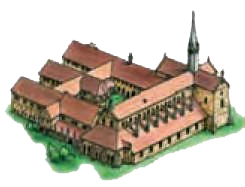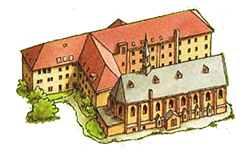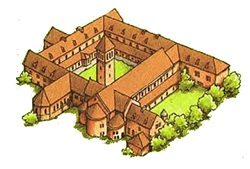Mănăstiri speciale (prima ediție)
 |
Citești regulile pentru acest design al cartonașelor. |  |
 | Citește următoarele reguli dacă cartonașele tale arată astfel. |  |
| Dacă cartonașele tale au un design diferit, atunci alege un joc din Spin-off-uri. |  |
Informații generale și comentarii

Extensia Mănăstiri din Germania (Klöster in Deutschland) a fost lansată original de Hans im Glück în 2014.
Extensia Mănăstiri din Țările de Jos și Belgia (de Kloosters) a fost lansată original de 999 Games în 2014. Hans im Glück a lansat de asemenea o versiune cu câteva schimbări asupra graficii și reguli identice în 2016.
Cele două extensii cu mănăstiri sunt extensii ambalate independent. Regulile pentru Mănăstiri din Germania și Mănăstiri din Țările de Jos și Belgia sunt identice.
Conținut
- Mănăstiri din Germania: 6 cartonașe de teren noi (Mănăstiri din Germania)
- Mănăstiri din Țările de Jos și Belgia: 6 cartonașe de teren noi (Mănăstiri din Țările de Jos și Belgia)
Reguli
Pregătire
Îndepărtează cartonașele „originale” cu mănăstiri și returnează-le în cutie.[1] Amestecă cele șase cartonașe noi cu mănăstiri cu restul cartonașelor de joc.
Atașarea unui cartonaș
Cartonașele acestei extensii sunt plasate urmând regulile de bază ale jocului Carcassonne.
Plasarea unui supus
Dacă un jucător trage unul dintre cartonașele cu mănăstire germană, îl plasează în conformitate cu regulile normale. După aceea are două opțiuni la plasarea unui supus pe mănăstire:[2][3][4]
- Drept călugăr: Cu această opțiune, mănăstirea este tratată ca o mănăstire din jocul de bază, iar toate regulile de evaluare normale rămân aceleași; sau
- Drept abate: In this option, the follower is considered an abbot of the monastery. Cu această opțiune, supusul este considerat un abate al mănăstirii. Pentru a însemna asta, jucătorul plasează supusul pe laterala sa, cu scopul de a semnifica că mănăstirea specială va fi evaluată diferit față de o mănăstire originală. Mănăstirea aduce puncte doar la sfârșitul jocului.[5][6] Prin urmare, abatele rămâne pe cartonaș în timpul jocului și nu se întoarce la jucător.
Evaluare
Evaluarea unui călugăr
Un supus plasat pe o mănăstire drept călugăr urmează regulile obișnuite de evaluare ale jocului Carcassonne.
Evaluarea finală a unui abate
Un abate de pe o mănăstire nu este evaluat până la sfârșitul jocului. Pentru abatele său, jucătorul primește câte 1 punct pentru fiecare cartonaș prezent în coloana verticală și rândul orizontal dinspre mănăstire. Cartonașul cu mănăstirea însăși aduce de asemenea 1 punct. Orice spațiu gol din rândul sau coloana mănăstirii întrerupe seria de cartonașe care aduc puncte mănăstirii.[7]

Notă: De dragul clarității, segmentele din completări corespund cu numărul de cartonașe din coloana de sus, rândul din dreapta, coloana de jos, rândul din stânga și respectiv cartonașul cu mănăstire însuși.
Ansamblul cartonașelor
Mănăstiri din Germania
Mănăstiri din Țările de Jos și Belgia
Ediția 999Games (2014)
Ediția HiG (2016)
Mănăstirile în detaliu
Mănăstiri din Germania

|
Mănăstirea Andechs (Bavaria) Situată pe malul de est al lacului Ammersee, Mănăstirea Andechs este cel mai vechi loc de pelerinaj din Bavaria. A fost fondată în 1455 ca o filială a călugărilor benedictin. De asemenea, mănăstirea este cunoscută departe dincolo de granițele Bavariei pentru berea sa. |

|
Mănăstirea Eberbach (Hessa) Mănăstirea Eberbach este o fostă abație cisterciană de lângă Eltville. Mănăstirea a fost fondată în secolul al XII-lea, iar cu caracteristicile sale romanice și gotice timpurii, este unul dintre cele mai importante monumente din Europa. A câștigat faimă mondială ca locație de filmare pentru ecranizarea romanului „Numele trandafirului” de Umberto Eco. |

|
Mănăstirea Lorch (Baden-Württemberg) Lorch, o fostă mănăstire benedictină, este situată pe o creastă de munte deasupra văii Rems, și este vizibilă de la depărtare. A fost donată în 1102 de ducele Frederic I de Suabia și familia sa. Apogeul mănăstirii benedictine a fost la sfârșitul Evului Mediu. Chiar și astăzi, mănăstirea fermecătoare, completă cu biserică, loc de adăpost, construcții de fermă și o grădină, înconjurată de un zid circular, este încă completă și intactă și încă atrage mulți vizitatori. |

|
Mănăstirea Maria Laach (Eifel/Renania-Palatinat) Fondată în 1093, Maria Laach este o mănăstire foarte medievală, situată pe partea de sud-vest a lacului Laacher. Un reper al acestei mănăstiri benedictine este biserica cu 6 turnuri a mănăstiri, Laacher Munster. |

|
Mănăstirea Marienthal (Saxonia) Mănăstirea Marienthal este cea mai veche mănăstire a Ordinul cistercian din Germania. A fost în funcționare continuă de la fondarea sa din 1234 până astăzi. Este situată lângă Görlitz, la triunghiul de granițe dintre Germania, Polonia și Republicii Cehia. |

|
Mănăstirea Maulbronn (Baden-Württemberg) Mănăstirea Maulbronn, o fostă abație cisterciană care este acum recunoscută acum ca patrimoniu mondial, este considerată a fi cea mai bine conservată mănăstire medievală la nord de Alpi. Fondată în secolul al XII-lea, toate stilurile și nivelurile de dezvoltare a perioadei romanice până în perioada gotică târzie sunt reprezentate aici. |
Mănăstiri din Țările de Jos și Belgia
Note de subsol
Pentru licențierea și semnificația pictogramelor te rugăm să vizitezi Pagina pictogramelor.
- ↑
 Ca alternativă, cartonașele cu mănăstirile speciale pot fi adăugate pur și simplu la cartonașele obișnuite fără a îndepărta cartonașele originale cu mănăstiri. Totuși, dacă se joacă cu jocul de bază și fără nicio altă extensie, asta s-ar putea să ducă la prea multe cartonașe cu mănăstiri. (4/2014)
Ca alternativă, cartonașele cu mănăstirile speciale pot fi adăugate pur și simplu la cartonașele obișnuite fără a îndepărta cartonașele originale cu mănăstiri. Totuși, dacă se joacă cu jocul de bază și fără nicio altă extensie, asta s-ar putea să ducă la prea multe cartonașe cu mănăstiri. (4/2014)
- ↑
 Aceste două opțiuni sunt disponibile ori de câte ori un supus ar urma să fie plasat pe mănăstirea specială: plasarea inițială a supusului, mutarea căruței, coridor fermecat, aparat de zbor etc. (5/2014)
Aceste două opțiuni sunt disponibile ori de câte ori un supus ar urma să fie plasat pe mănăstirea specială: plasarea inițială a supusului, mutarea căruței, coridor fermecat, aparat de zbor etc. (5/2014)
- ↑
 Remarcă că mănăstirea specială este doar un singur teritoriu, chiar dacă poate fi folosit în două moduri. Prin urmare, dacă este ocupată de un supus, un jucător nu poate plasa aici fantoma sa, muta aici căruța sa sau plasa un supus de-al său prin intermediul unui coridor fermecat sau aparat de zbor. (7/2014)
Remarcă că mănăstirea specială este doar un singur teritoriu, chiar dacă poate fi folosit în două moduri. Prin urmare, dacă este ocupată de un supus, un jucător nu poate plasa aici fantoma sa, muta aici căruța sa sau plasa un supus de-al său prin intermediul unui coridor fermecat sau aparat de zbor. (7/2014)
- ↑
 Dacă un al doilea supus este plasat pe o mănăstire specială prin intermediul utilizării unui aparat de zbor, jucătorul poate alege să facă noul supus fie călugăr, fie abate, indiferent de identitatea primului supus de acolo. Totuși, dacă mănăstirea specială este deja înconjurată de 8 cartonașe, prin urmare reprezentând o mănăstire finalizată, cel de al doilea supus trebuie să fie abate. (7/2014)
Dacă un al doilea supus este plasat pe o mănăstire specială prin intermediul utilizării unui aparat de zbor, jucătorul poate alege să facă noul supus fie călugăr, fie abate, indiferent de identitatea primului supus de acolo. Totuși, dacă mănăstirea specială este deja înconjurată de 8 cartonașe, prin urmare reprezentând o mănăstire finalizată, cel de al doilea supus trebuie să fie abate. (7/2014)
- ↑
 Deoarece un supus plasat drept abate este evaluat doar la sfârșitul jocului, iar această mănăstire specială nu este considerată niciodată finalizată în acest caz, o mănăstire cu un supus plasat drept abate nu poate aduce puncte unui supus dintr-o cetate. (5/2014)
Deoarece un supus plasat drept abate este evaluat doar la sfârșitul jocului, iar această mănăstire specială nu este considerată niciodată finalizată în acest caz, o mănăstire cu un supus plasat drept abate nu poate aduce puncte unui supus dintr-o cetate. (5/2014)
- ↑
 Un meeple plasat drept abate nu poate fi implicat într-un duel cu un eretic de pe un lăcaș de cult, din moment ce cele două mecanisme de evaluare sunt total diferite (mănăstirea abatelui nu este niciodată finalizată, așa că ereticul ar câștiga mereu). (5/2014)
Un meeple plasat drept abate nu poate fi implicat într-un duel cu un eretic de pe un lăcaș de cult, din moment ce cele două mecanisme de evaluare sunt total diferite (mănăstirea abatelui nu este niciodată finalizată, așa că ereticul ar câștiga mereu). (5/2014)
- ↑
 Atunci când se folosesc mănăstiri speciale, bonusul viei este aplicat mănăstirii speciale dacă supusul este plasat drept călugăr și teritoriul este evaluat ca o mănăstire finalizată. Totuși, bonusul viei nu este aplicat dacă un supus este plasat drept abate pe o mănăstire, din moment ce abatele aduce puncte doar la sfârșitul jocului, când via nu are niciun efect. (5/2014)
Atunci când se folosesc mănăstiri speciale, bonusul viei este aplicat mănăstirii speciale dacă supusul este plasat drept călugăr și teritoriul este evaluat ca o mănăstire finalizată. Totuși, bonusul viei nu este aplicat dacă un supus este plasat drept abate pe o mănăstire, din moment ce abatele aduce puncte doar la sfârșitul jocului, când via nu are niciun efect. (5/2014)



























